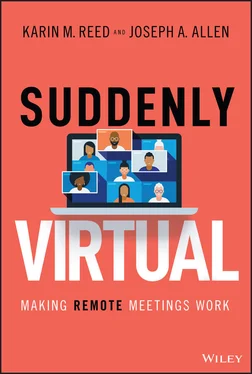CHAPTER 1 What Happened to Meetings?: The Meeting Scientist Perspective
Perhaps an important question to ask is “When did the world change?” Certainly, the world changed quickly, and many workers were either without work or found themselves in a dramatically different work environment. While the change was nearly instantaneous for some, others experienced a more gradual progression as the world tried to navigate the uncharted territory of a global pandemic. The facts on the ground shifted – not just day by day, but also hour by hour. A universal sense of uncertainty bled into every aspect of our lives.
The business world sought to adapt to the changes, but in those early days, ever‐changing information meant that plans were scrapped almost as soon as they were written.
In this chapter, we will explore:
The sequence of events that led to much of the world of work going remote.
The rise of the virtual meeting.
How businesses scrambled to adapt to the new virtual reality.
When did you first really pay attention to what was happening with COVID‐19? From your current vantage point, you may find it hard to believe that most of us did not give it a whole lot of thought when it first reared its ugly head in China. Few of us could have imagined then how it would soon turn our world upside down. However, you probably do remember a watershed moment which signaled a shift in mindset. Maybe it was the cancellation of the NBA season or the closure of your college campuses? That's when we were suddenly glued to the TV and felt like we could not keep up with the news or the changes swiftly overtaking every aspect of our lives. The pandemic was a force to be reckoned with, and no one was going to be left unimpacted.
To put what happened to work and workplace meetings into proper context, here's a quick timeline of events.
| Timeline of Events from the COVID‐19 Pandemic(Kantis, Kiernan, and Bardi 2020) |
| December 8, 2019 |
A patient in the city of Wuhan sought medical help for pneumonia‐like symptoms. |
| January 3, 2020 |
China officially notifies the WHO of an outbreak. |
| January 21, 2020 |
United States confirms its first case in Washington state, a man who traveled to the Wuhan area. |
| January 23, 2020 |
WHO meets again and decides not to declare the outbreak a Public Health Emergency of International Concern (PHEIC). |
| January 24, 2020 |
Nepal, Vietnam, France, and Malaysia confirm their first cases. Wuhan construction crews are working on two hospitals to treat patients of the outbreak: the first is to be completed on February 3 and the second in early February. |
| February 4, 2020 |
The U.S. Food and Drug Administration issues an emergency use authorization for CDC's diagnostic test. President Trump pledges to safeguard Americans from the coronavirus in his State of the Union address. |
| February 7, 2020 |
Total Cases Confirmed Globally: 31,484. |
| February 10, 2020 |
The United Kingdom declares that the coronavirus constitutes a serious and imminent threat to public health. The Trump administration releases a budget proposal for FY21 that would sharply cut funding for WHO and global health funding. |
| February 13, 2020 |
U.S. CDC Director says that the coronavirus will likely become a community virus and remain beyond this season. |
| February 15, 2020 |
The United States announces plans to evacuate nearly four hundred Americans quarantined on the Diamond Princess cruise ship; passengers who test positive for COVID‐19 will be treated in Japan. |
| February 25, 2020 |
U.S. CDC warns that spread to the United States is likely and that people should prepare. |
| February 29, 2020 |
Australia reports its first death, an evacuee from the Diamond Princess. The United States reports its first death, a man in his fifties with an underlying health condition. Washington state declares a state of emergency. |
| March 7, 2020 |
Roughly 5,861 coronavirus tests are completed by CDC and public health labs in the United States. New York declares a state of emergency. |
| March 11, 2020 |
WHO declares the coronavirus outbreak a pandemic. Washington, D.C., declares a state of emergency. United States announces level 3 travel advisory and suspends entry to all foreign nationals traveling from China, Iran, and certain European countries at any point during the 14 days prior to their scheduled travel to the U.S. NBA suspends their season. Italy closes all shops and venues across the country. The United Nations reports that about 20% of students are out of school globally as a result of the pandemic. |
| March 12, 2020 |
U.S. stocks record their worst day since 1987. New York City declares a state of emergency. Ohio closes all public schools until at least April 3, 2020. France closes all schools. Virginia declares a state of emergency. |
As of the writing of this book, more than 81 million people have been infected and over 1.8 million have died from the pandemic worldwide. Cases occurred in 188 countries, with many of them seeing their citizens dying from this disease.
The public health response has varied from country to country, with some shutting down immediately and asking citizens to stay home for weeks (e.g. South Korea) and others simply waiting for herd immunity to be achieved (e.g. Sweden). In the United States and many other countries the world over, the pandemic shut down the economy, the schools, and our favorite restaurants. Essential workers (e.g. some in manufacturing and many in grocery stores, farms, meatpacking, and so on) carried on in their work to feed the population, and so also carried the initial brunt of the burden of the disease.
As this happened, teachers learned how to go fully online, parents learned how to teach kids from home, and many organizations required their employees to work remotely. The kitchen table, bedroom, back porch, or home office became many people's only office. Demand for computers, webcams, headsets, desks, standing desks, monitors, and even “desk treadmills” skyrocketed, making some firms scramble to deal with supply, and with some individuals waiting for weeks for key tools they needed to go fully remote.
For years, organizations danced around the work‐from‐home issue. Some workers who sought the flexibility of a work‐from‐home life were denied time and again. Flexible work schedules were a niche area in academic research and even more niche in the actual workplace. Then, COVID‐19 hit, and everyone was “suddenly virtual.” The organizational sciences refer to this event as an equilibrium shift. Although the world had its challenges in October 2019, the economies were humming along at what might be called equilibrium. Then, a sudden and deep shock to the system occurred and fully unfolded over the following few months. In psychology, key events in one's life might be considered flashbulb moments, such as, in the past, “Where were you when Neil Armstrong landed on the moon?” or “Where were you on 9/11?” Now, we have, “Where were you during the COVID‐19 pandemic?”
Like so many knowledge workers, Karin's office became a time capsule of March 2020, with sticky notes on the wall reflecting to‐do lists for projects that were either scrapped or put on hold until a later date. One particularly poignant email from that time from Karin to a client read in part, “Let's reschedule the workshop for June. Surely things will be back to normal by then.” Hindsight, of course, reveals the level of denial or even folly in those words. Even at the end of 2020, attempting to reschedule large group trainings seems ill‐conceived. Luckily, Karin already had been delivering a third of her training virtually for years, but with COVID‐19, that third became 100% of her business practically overnight.
Читать дальше












